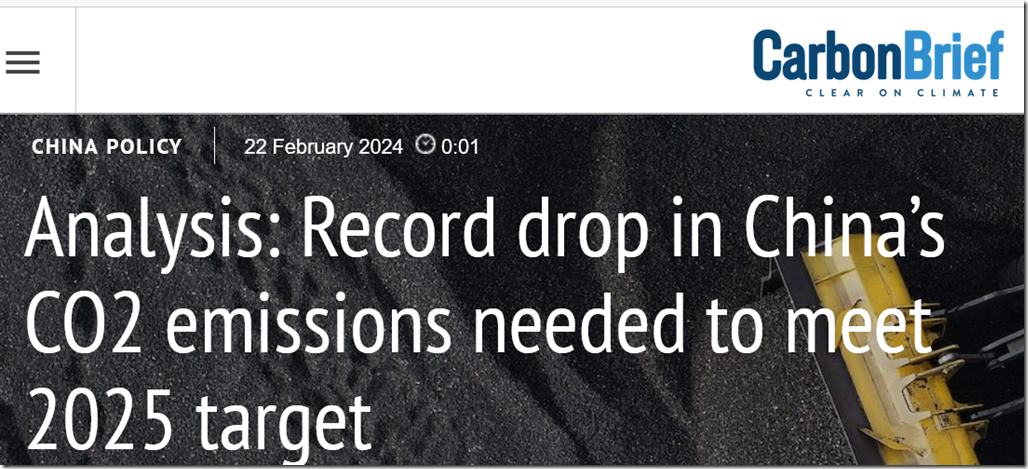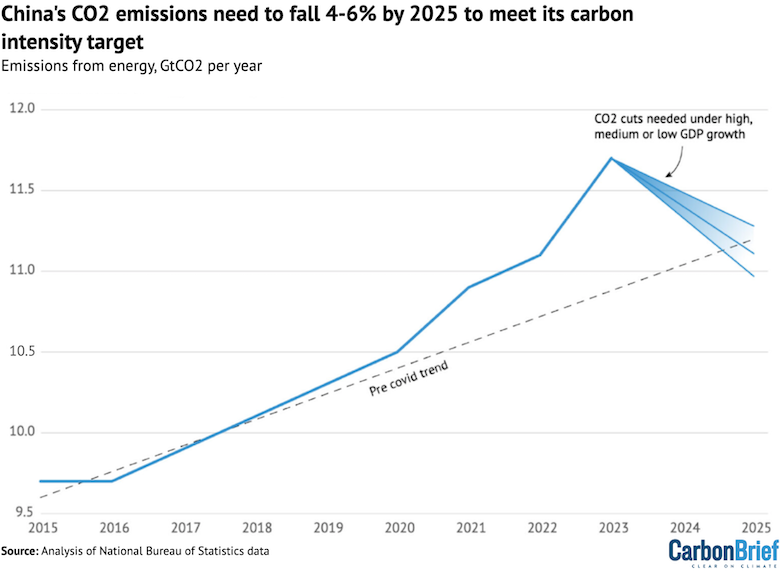China Emissions Rose By 5.2% Last Year
MARCH 28, 2024tags: ChinaBy Paul Homewood
From Carbon Brief
China’s energy sector carbon dioxide (CO2) emissions increased 5.2% in 2023, meaning a record fall of 4-6% is needed by 2025 to meet the government’s “carbon intensity” target.
The new analysis for Carbon Brief, based on official figures and commercial data, shows rapid electricity demand growth and weak rains boosted demand for coal power in 2023, while the rebound from zero-Covid boosted demand for oil.
Other key findings from the analysis include:
- China’s CO2 emissions have now increased by 12% between 2020 and 2023, after a highly energy- and carbon-intensive response to the Covid-19 pandemic.
- This means CO2 emissions would need to fall by 4-6% by 2025, in order to meet the target of cutting China’s carbon intensity – its CO2 emissions per unit of economic output – by 18% during the 14th five-year plan period.
- China is also at risk of missing all of its other key climate targets for 2025, including pledges to “strictly limit” coal demand growth and “strictly control” new coal power capacity, as well as targets for energy intensity, the share of low-carbon energy in overall demand and the share of renewables in energy demand growth.
- Government pressure to hit the targets, most of which are in China’s updated international climate pledge under the Paris Agreement, makes it more likely that China’s CO2 emissions will peak before 2025 – far earlier than its target of peaking “before 2030”.
According to preliminary official data, China’s total energy consumption increased by 5.7% in 2023, the first time since at least 2005 that energy demand has grown faster than GDP.
With coal consumption growing by 4.4%, our analysis shows CO2 emissions increasing by 5.2% – at the same rate as GDP – highlighting energy-intensive recent growth patterns.
China’s economic growth during and after the Covid-19 pandemic has been highly energy- and carbon-intensive. CO2 emissions grew at an average of 3.8% per year in 2021-23, up from 0.9% a year in 2016-20, while GDP growth slowed from an average of 5.7% to 5.4%.
Another year of rapidly rising emissions in 2023 leaves China way off track against its target of cutting carbon intensity by 18% during the 14th five-year plan (2021-25).
As a result, CO2 emissions would now need to fall by 4-6% by 2025 to hit the goal. This is illustrated in the figure below, showing historical emissions (blue line) and the reductions needed by 2025 to hit the carbon intensity target, depending on the rate of GDP growth.
Even if China’s GDP growth is high and averages 6% per year in 2024-25, the intensity target requires CO2 emissions to fall by 4%.
https://www.carbonbrief.org/analysis-record-drop-in-chinas-co2-emissions-needed-to-meet-2025-target/
The idea that this is all some sort of bounce back from COVID is patently absurd, as there never really was a drop off in 2020. As the graph shows, the rate of increase has been steadily rising for years.
In simple numbers, CO2 emissions are now 11.7% higher than in 2019, pre pandemic.
None of this should surprise anybody, but apparently it still does.
- Forums
- Political Debate
- Accelerate the World's Transition to Sustainable Energy - to fight Anthropogenic Climate Change
Accelerate the World's Transition to Sustainable Energy - to fight Anthropogenic Climate Change, page-31625
Featured News
Featured News
The Watchlist
BTH
BIGTINCAN HOLDINGS LIMITED
David Keane, Co-Founder & CEO
David Keane
Co-Founder & CEO
Previous Video
Next Video
SPONSORED BY The Market Online











